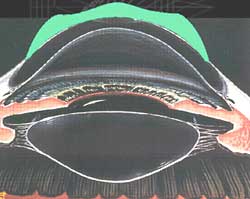Laser ablated contact lenses allow preop preview of surgical effect
The treatment is based on induction of positive spherical aberration, which compensates for the loss of accommodation in presbyopic eyes.
A method of simulating presbyopia-correcting laser surgery on contact lenses allows patients to see the effects of the treatment before giving their final consent to surgery.
Franco Bartoli, MD, said that transferring the laser treatment from the cornea to the lens was not an easy task.
“The ablation rate of the excimer laser on the surface of a contact lens is very different than on the human cornea. After a very long series of trials and calculations we concluded that the ratio is about 1 to 3. When we perform the treatment on the lens we must use three times the power we use on the cornea,” he said.
Dr. Bartoli said another problem comes from the fact that the radius of corneal curvature coincides with the internal and not the external radius of the lens, where the laser ablation is performed.
“This difference required another series of calculations and adjustments,” he pointed out.
Other adjustments were required because the treatment is performed on daily disposable dehydrated contact lenses, and the final aberrometric results have to be calculated taking into account the changes of the lens after hydration.
Induction of spherical aberration
|
Image: Bartoli F |
Dr. Bartoli’s method of presbyopia correction is based on the manipulation of Zernike polynomial z(4.0). In his previous research, based on dynamic wavefront analysis, he demonstrated that a close correlation exists between accommodation and spherical aberration: while in the eye at rest from accommodation spherical aberration is zero or slightly negative, during accommodation spherical aberration becomes positive.
“When the eye becomes presbyopic, and loses its ability to accommodate, it also loses its ability to induce spherical aberration,” he explained.
By inducing a certain amount of positive spherical aberration, his laser treatment aims at compensating for the loss of accommodation in presbyopic eyes.
“It’s a simple concept that works very well in practice,” Dr. Bartoli said. Since 2002 he has treated 339 eyes, hyperopic, myopic and emmetropic, and his best results, contrary to most laser presbyopic procedures, are with myopic patients.
In the first 2 years he used the WASCA aberrometer and Mel 70 excimer laser (Carl Zeiss Meditec), and he now uses the CRS Master and Mel 80.
“Patients recover near vision and maintain their preoperative distance vision with no loss of contrast sensitivity, glare, halos, ghosting or double images,” Dr. Bartoli pointed out.
He performs his treatment using PRK, but he said other surgeons have experienced it with LASIK as well.
The treatment on the lens
On contact lenses, spherical aberration is measured through the lens meter on two different focal distances, for far and near vision.
“What we obtain is a multifocality on the horizontal axis, like the natural zooming of a young eye,” Dr. Bartoli said. “We start from a lens with the refraction of the patient we want to treat, for example –5 D, and induce the calculated amount of spherical aberration on top of it. The patient tries it and then decides if he or she wants to have the treatment on the cornea.”
The result, he added, is extremely precise in myopic contact lenses, but not always as precise in hyperopic lenses.
“For hyperopia, we haven’t yet found a mathematical formula that gives predictable and reproducible results in all cases. We are fairly satisfied, but not completely, and are still trying to improve our method for these patients,” Dr. Bartoli said.
Patient response
Contrary to his expectations, the preoperative simulation on the lens seems to be “more reassuring for the ophthalmologist than for the patient.”
Most candidates for presbyopic refractive surgery, he said, are quite sure of what they want when they come in for a consultation.
“Quite a few of them have been wearing contact lenses for years, are highly motivated to get rid of spectacles, and when they come to us they have already made up their mind about having the treatment. In some cases, they don’t even want to try the modified contact lens beforehand,” Dr. Bartoli said.
Among those who are still unsure, about half decide to have the surgery, and the other half go home happy with the new contact lenses.
“Those who have tried both the lenses and the treatment, are of course a lot happier after the corneal treatment, which gives them the comfort and the stable quality of vision which no contact lens can give,” he said.
He added that in the future an interesting experiment would be to compare different presbyopic laser treatments on contact lenses, having the same patient judging the visual outcome of one treatment in one eye, and another treatment in the fellow eye.
For more information:
- Franco Bartoli, MD, can be reached at Via San Quintino 4 bis, 10100 Torino, Italy; +39-011-549847; fax: +39-011-5624022; e-mail: franco.bartoli@alice.it.
- Michela Cimberle is an OSN Correspondent based in Treviso, Italy, who covers all aspects of ophthalmology. She focuses geographically on Europe.

